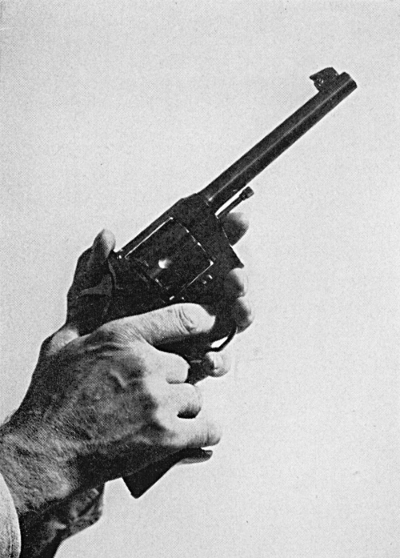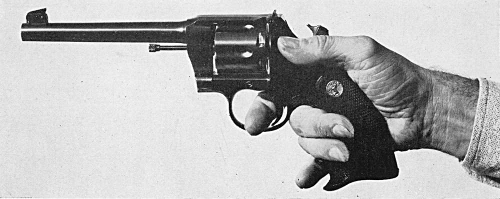The following information comes from The Elusive Ten by William Reichenbach. The Elusive Ten is also available to purchase in print.
Considerable emphasis should be placed on proper grip. While you, being an intelligent person, would not attempt to hold your gun as if it were a coffee spoon or a tomahawk, you will endeavor, at any rate, to take some natural grip which will cause the least fatigue. Something like this:
Hold the stock of your gun between the ball of your thumb and your middlefinger. (You really could shoot that way.) But, in order to put the other fingers away, you might just as well place your thumb along the upper edge of the plate (on the cylinder latch), parallel to the hammer, and drape the ring and little fingers gracefully wherever they find a place on the grip of the gun. Mind you, just drape the fingers around the stock, and do not touch the stock with your fingertips at all.
The lower part of the trigger finger touches the frame and should steady it. The little finger, also with its lower portion, does the same further down the stock.
The action of the first two digits of the trigger-finger is being dealt with under the chapter entitled Squeeze.
That seems to be the whole secret of Grip. However, it may not be amiss to amplify this statement. There is a reason for everything, as you will see presently.
Let us go at it systematically.
Hold on! Do not pick up the revolver with your right hand and manipulate it into position by the fingers of that hand unaided by the left. No, sir! Instead, hold the weapon by the left hand and “fit” it into your right hand (See Illustration I). Never overlook an opportunity to give your right hand every possible help, no matter how inconsequential it may seem.

Fitting The Gun
The five fingers of the left hand support the weight of the gun until the fitting into the right hand is completed. If the gun should be cocked the left thumb which rests under the hammer, is withdrawn only after the fitting is completed.
How the revolver should be grasped is illustrated by the accompanying illustration (See Illustration II). Note particularly the position of thumb and fingertips.

Holding the Gun
The general impression which the picture gives is that of complete absence of strain or effort. It appears as if the hand were holding a musical instrument.
Observe the shadows which middle- and ring-fingers throw on the stock of the gun, illustrating that the finger-tips are kept away from the stock altogether. The thumb rests on the cylinder-latch. One can distinctly see the little-finger support the right side of the stock while the tip is also kept away from the stock.
Although the revolver handle is known as its “grip,” that should be no reason for gripping it as though you feared some one might attempt to yank it out of your hand.
A short explanation of the various forces involved in grasping a revolver properly should prove helpful, not only as a matter of correct learning, but also as an aid in acquiring consistency. The weapon is supported by the middle finger; in fact, it literally hangs on it. Close to the second joint and on the side of the middle finger (i.e. the side nearer the thumb) is the point of support. On the revolver, the corresponding point is directly in the rear of the trigger guard. This point serves also as a fulcrum. The pressure exerted by the middle, ring, and little fingers towards the rear is opposed by the ball of the thumb. The vertical movement of the muzzle, caused by the working of the mechanism and recoil, is checked by the thumb resting on the cylinder latch and by the ball of the thumb. The horizontal movement of the muzzle is governed by the palm and the sides of the trigger and little fingers, as mentioned before and again the thumb, by its strategic position on the cylinder latch, comes into passive function.
Understand the foregoing and accept the fact that, contrary to the beginner’s usual conception, the revolver may be grasped almost lightly—in fact, just firmly enough to withstand the shock of recoil. That, you will quickly find, is beneficial in many ways. It is less tiring. The gun remains steadier. Your motions and reactions are less acute, etc. Just regard the revolver as a delicate instrument and hold it accordingly. (See Illustration II.)
By now you will readily appreciate the importance of what I said previously. Do not touch the revolver grip with your finger tips! The slight pressure they exert, the amount of which you cannot control, will destroy the delicate state of balanced forces (opposing pressures) which you are seeking to establish and maintain until after the weapon is discharged.
Practice holding your revolver. Study the illustration II. Observe how the various forces (pressures) which you exert balance and offset each other. Do not be satisfied until the revolver feels natural and until you grasp it in exactly the same manner each time you take hold of it.
